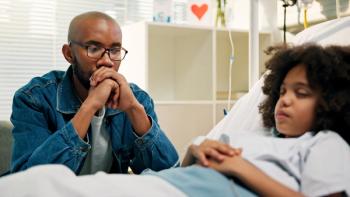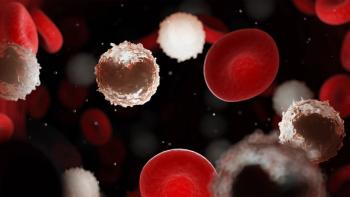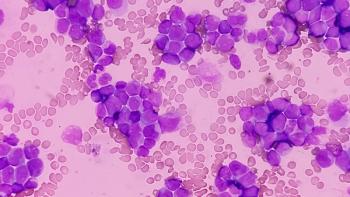
Childhood Cancer Survivors Likely to Deliver Healthy Babies, But May Require Additional Monitoring During Pregnancy
Childhood cancer survivors may benefit from high-risk obstetric care despite being able to conceive and give birth safely.
Female cancer survivors are as likely to give birth to healthy babies as women who were not treated for cancer, according to a study recently published in the Journal of the National Cancer Institute.1 However, female cancer survivors are more likely to develop a severe complication during pregnancy or labor than those without a history of cancer, the data caution.
Findings showed that female cancer survivors were just as likely as the general female population to carry a pregnancy past 20 weeks (relative risk [RR] = 1.01; 95% CI, 0.98-1.04) and that there was no difference in birth defects or Agpar scores between babies born in the survivor or control group cohorts.2
Among more than 4000 cancer survivors, only 87 women (2%) experienced a serious complication during labor or developed a heart problem during pregnancy. Furthermore, cancer survivors were twice as likely to experience these difficulties compared with non-cancer survivors.
At 30 years old, women who had survived cancer had a cumulative incidence of achieving a recognized pregnancy of 22.3% (95% CI, 20.7%-23.9%) compared with 26.6% (95% CI, 25.6%-27.3%) among the general population (HR, 0.80; 95% CI, 0.75-0.86). Risk factors for a lower likelihood of conception included history of a brain tumor, alkylator chemotherapy, cranial radiation, or hematopoietic stem cell transplantation (HSCT).
“The message here is largely positive,” said study leader Paul Nathan, MD, of the Hospital for Sick Children in Toronto, Canada. “Women who have a history of childhood cancer have a really good chance of getting pregnant, and most of them are quite fine through the pregnancy. But it’s super important for the people caring for them to know about these risks.”
Investigators identified 4062 women who had underwent cancer therapy between 1985 and 2012 while they were under the age of 21 years. All evaluable patients were identified via a single-payer health insurance program covering Ontario, Canada. Each patient with a history of cancer was compared with 5 women with no history of cancer. In total, the survivors were compared against 20,308 comparisons women from the general population, totaling in an assessment of over 24,000 women.
Although women who had received treatment were just as likely to give birth to a healthy baby as women from the general population, they were at an increased risk of severe maternal morbidity (RR, 2.31; 95% CI, 1.59-3.37), cardiac morbidity (RR, 4.18; 95% CI, 1.89-9.24), and preterm birth (RR, 1.57; 95% CI, 1.29-1.92). Furthermore, patients who had received allogenic HSCT were more likely to experience a preterm birth (RR, 8.37; 95% CI, 4.83-14.48) as did those who underwent autologous transplant (RR, 3.72; 95% CI, 1.66-8.35).
These results suggest that female cancer survivors may benefit from high-risk obstetric care, although in the United States, ensuring that survivors know to seek these resources could be improved through better communication between providers, noted experts.
“High-risk obstetric care is widely available in most of the country, but childhood cancer survivors may not be recognized as needing that kind of care,” Emily Tonorezos, MD, director of NCI’s Office of Cancer Survivorship, commented on the study. Tonorezos noted that health care providers may not know that their patient was treated for cancer as a child, particularly if they have relocated between cities or states and transferred to a new medical system.
“The burden of making sure you’re getting good health care is very often on the survivor and their family,” added Tonorezos. “That’s not where the burden should be, but survivors need to [make sure] health care providers have some of that information, because sharing data is not built into our health system,” she added.
Nathan agreed that women who were treated for cancer before the age of 21 would benefit from frank conversations with their providers about a potential need for high-risk obstetric care. This high-risk care could encompass heath monitoring throughout pregnancy, as well as frequent fetal monitoring. The key, according to Nathan, will be ensuring that all the providers caring for a childhood cancer survivor understand their medical history.
“Health care providers’ knowledge of a patient’s cancer history can also spur other important conversations about reproductive health,” he said. “[Figuring out] how to share this information with health care providers is going [to be] one of our key goals.”
Overall, however, these findings are promising for cancer survivors, as they suggest that a healthy pregnancy is possible with a little additional monitoring, concluded experts. “The expectation of a healthy pregnancy and a healthy baby should be the norm, even for childhood cancer survivors,” said Tonorezos.
Reference
1. Zgardau A, Ray JG, Baxter NN, et al. Obstetrical and perinatal outcomes in female survivors of childhood and adolescent cancer: a population-based cohort study. Published online ahead of print January 19, 2022. J Natl Cancer Inst. doi:10.1093/jnci/djac005
2. NCI Staff. Good News and cautions about pregnancy for childhood cancer survivors. National Cancer Institute. March 4, 2022. Accessed March 28, 2022. https://bit.ly/3iJyGoA
Newsletter
Knowledge is power. Don’t miss the most recent breakthroughs in cancer care.
















































































